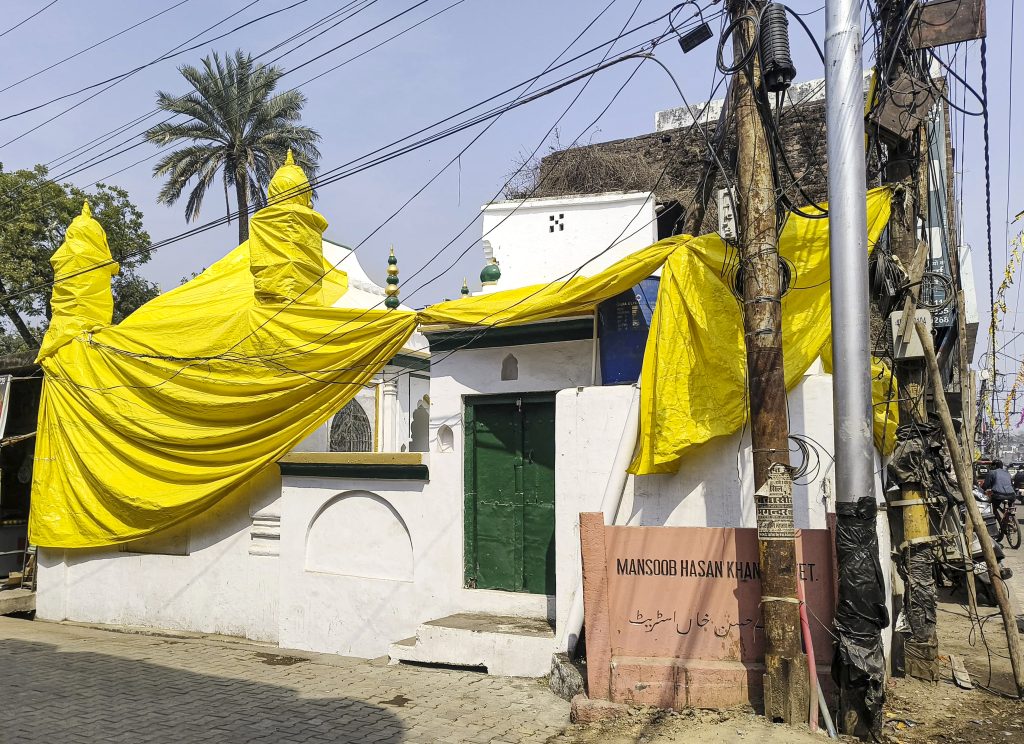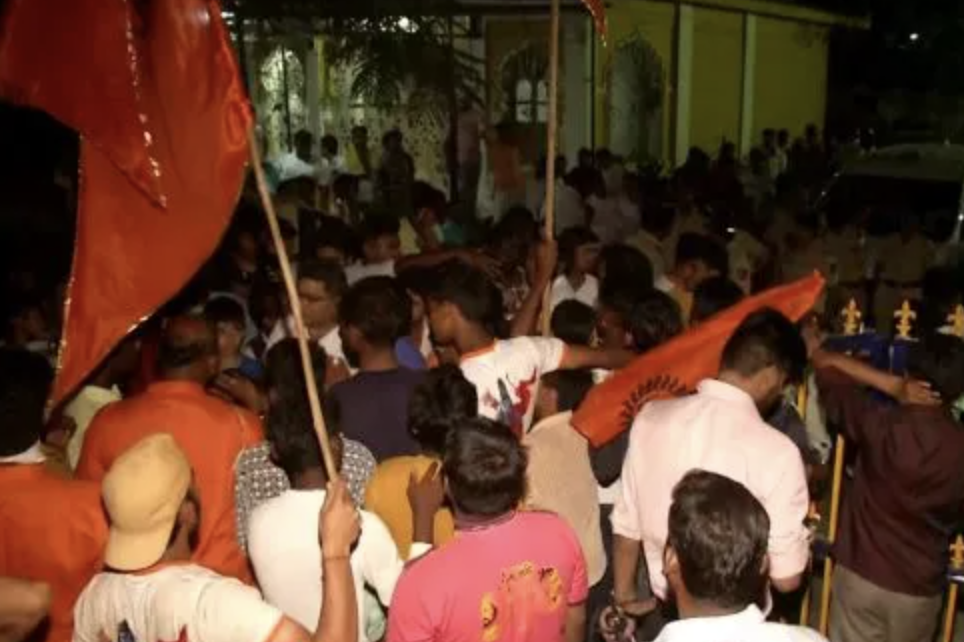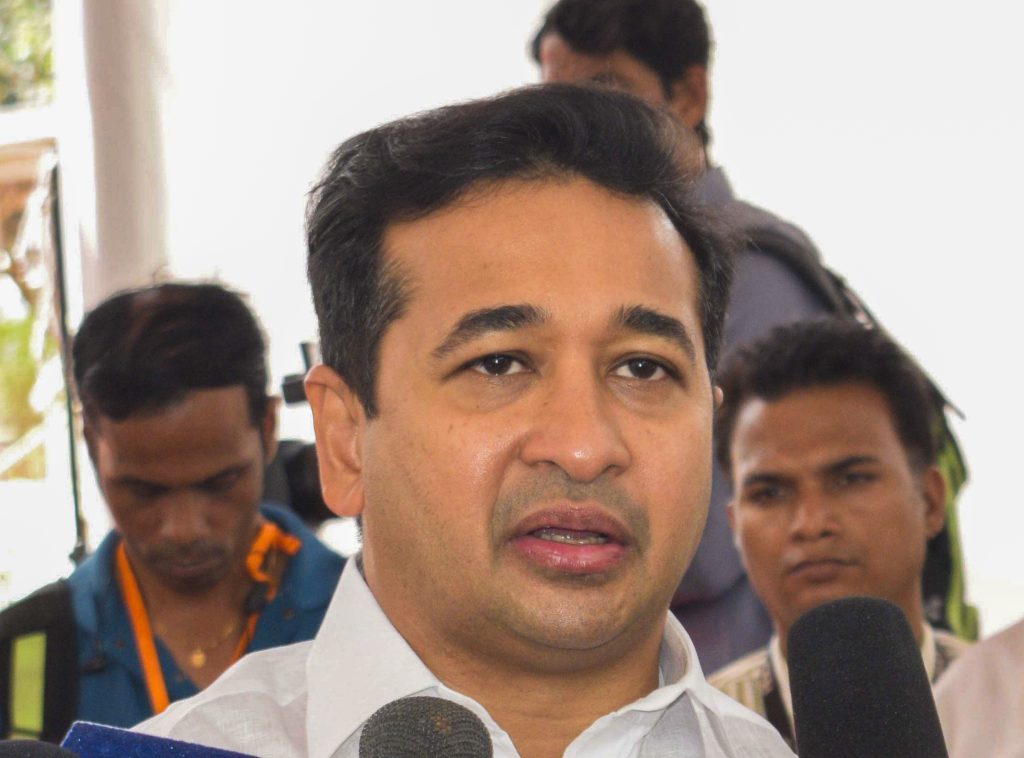In UP’s Mosque Coverings, a New Chapter From The Hindutva Playbook Unfolds
As the country celebrated Holi last week and a riot of colours ensued, a few sites stood out, not for their vibrant colours, but for their erasure.
These sites remained covered, beneath cloth and tarpaulin, as if their existence had to be hidden.
These sites were mosques, scattered across various parts of Uttar Pradesh. The idea, Uttar Pradesh police officials confidently put forth, was that this way, Hindu processionists could celebrate Holi freely and “any law and order situation can be avoided”, cops told journalists. Chief minister Adityanath was less coy. Speaking on an ANI podcast, he likened Holi processions attempting to throw colours at mosques to Muharram processions casting a "shadow" over temples.
As a result, nearly 200 mosques were engulfed entirely with tarpaulin sheets, invisibilising them for the convenience of Hindu revellers.

A mosque covered in tarpaulin as prevention against possible holi colour, ahead of traditional 'Laat Saheb' procession on Holi, in Shahjahanpur, Uttar Pradesh, Wednesday, March 12, 2025. Photo: PTI.
For a while, we have seen how Hindu festivals have become playgrounds for Hindutva groups to stoke tensions and violence.
But what happened in Uttar Pradesh on Holi is a new piece of the Hindutva playbook that has slowly been emerging in various spots like Hyderabad, on Ram Navami – the idea that mosques and Muslim localities are, essentially, obstructions in the way of Hindus to celebrate their festivals or take out processions.
These obstructions, since they cannot be done away with entirely, can at least temporarily be erased, made non-existent and invisibilised using tarpaulin sheets.
That the state agrees and encourages the covering of mosques is worrisome for multiple reasons: by doing so, the state is unwittingly admitting to the dangerously high level of radicalisation in the populace, so high that the mere sight of a mosque can unbalance their mental faculties and cause them to attack it.
The state, in covering the mosques, is making another confession: that it is either unwilling (believably) to control such mobs or, worryingly for us, it is now longer possible to rein them in, even if the police want to. Which is why, it is easier to now appease them and hope that they aren’t annoyed or displeased with any Islamic sights, lest they are forced to riot.
History repeats….
Across different states, the processions are now a common form of communalism, a medium through which you can create small, local-level tensions and clashes between Hindus and Muslims.
Such localised communalism helps top political leaders escape accountability and also ensures that hate stays off the headlines, owing to its localised nature – most media outlets would describe these as “minor” clashes.
In 2023, a report titled ‘The Routes Of Wrath’, attempted to look at these seemingly localised clashes that occurred in 2022 and realised that they had occurred in 12 different states, on the occasions of Ram Navami and Hanuman Jayanti: Gujarat, Jharkhand, Madhya Pradesh, Delhi, Uttarakhand, Rajasthan, Maharashtra, Goa, West Bengal, Karnataka, Bihar and Andhra Pradesh.

Videos screengrabs and Twitter images of violence in Bengal's Howrah following Ram Navami processions in 2023.
Like Holi this year, both these occasions also fell in the holy month of Ramzan in 2022.
Historically, riots during festivals are not uncommon.
One of the earliest such instances recorded in history is in Salem in 1882, where a series of “bloody riots” were ignited with the passing of a Hindu procession before a mosque. Combined with this was an insistence by Hindu revellers in these processions to play music, right in front of mosques, as a way to assert their supremacy and provoke.
The signs of such a music-driven communalism were visible over a century ago, when in 1893, when Bal Gangadhar Tilak reconfigured the Ganpati festival to become a vehicle of mass mobilisation. Songs that came to be associated with the festival later, were tracks with incendiary words, like “What boon has Allah conferred upon you, that you have become Mussalmans today? Do not be friendly to a religion which is alien, do not give up your religion and be fallen”. Such rhetoric was helped in no small part by Tilak’s assertions, according to a paper by Julian Lynch, an ethnomusicologist, that “called upon Hindus to boycott the Muharram festival that year” and instead, celebrate Ganpati with fervour.
For decades, festivals remained the vehicle of mass Hindu mobilisation, commonly leading to violence and tensions.
In 1921, Mahatma Gandhi was forced to mention these riots in his Young India article, reminding Hindus that it “is not a matter of vital importance for him to play music while passing a mosque,” and asked both communities to respect each other’s concerns.
…but with a difference
Even if we are tempted to believe that these riotous processions are simply a continuation of our country’s communal past, there are now significant departures in the way these events are organised and unfold now.
To begin with, our New India’s leaders use these occasions to actively create divisions, unlike Gandhi’s approach of trying to mediate and unify.
Adityanath, for instance, criticised Muslims for even expecting that their mosques won’t be covered in colour.
“Do Muslims not wear colourful clothes? Muslims wear more colourful clothes than Hindus. Then why do you have a problem with colours? These are double-standards…this can’t be accepted,” Adityanath said. The host of the ANI podcast did not bat an eyelid and moved on to her next question straight away.
In addition, the nature of the organisations backing such processions has changed immensely.
In Jharkhand, where Ram Navami is possibly the biggest public festival and sees anywhere between tens to hundreds of thousands of Hindus walking through the streets and typically end their procession at a temple, old-timers and police officials had told me how the festival had changed.
From being organised by various smaller Hindu groups, known as Akharas or mandals, in the recent years, Hindutva outfits like the Bajrang Dal started taking the lead role either by inserting their men into these mandals or pushing them away entirely.
Often, these processions, then, insist of changing the routes of these traditional marches by trying to take them through Muslim-dominated areas or localities which have major Muslim mosques, like it was the case in Kasganj in 2018, when Hindutva outfits insisted on a ‘Tiranga Yatra’ through Muslim localities and proceeded, even though the local administration denied them permission. The result was a series of violent clashes and the death of a 22-year-old Hindutva activist Chandan Gupta.
Like in Kasganj as well as in the case of the Bhagalpur riots of 1970 which left 74 dead, groups would insist on stopping these processions before mosques or Muslim homes and deliver hate speeches and slogans. However, now, this role has been outsourced to Hindutva pop (H-pop) music.
This music, with its incendiary lyrics, can often be worse than the most rabid of hate speeches—they contain overt calls for violence, threats against Muslims, calling them “Babur Ke Pillo”, containing claims of temples beneath mosques, declarations of India as an impending Hindu Rashtra.
Not too far from where I live, in Mumbai’s Malvani locality, this played out like a template:
On March 30, 2023, in Mumbai’s Malvani locality, a Ram Navami procession stopped before the Hazrat Ali Masjid. A song blared from loudspeakers:
“Main Hindu jagaane aaya hoon (I have come to awaken Hindus)."
The song had a call to arms: Hindus were ready to pick up swords to defend the motherland, it said.

A procession at Malvani on Ram Navami, 2023. Photo: Social media.
Thousands of men joined in, chanting Jai Shri Ram at the Muslims watching from nearby buildings. One Muslim, provoked, hurled footwear at the procession. The response was swift – Hindus retaliated with stones and sticks. The police barely prevented a full-scale riot.
That night, the Malvani police filed an FIR. Only Muslims were named. The provocation – the music, the slogans – was not an offence. The reaction was.
This has become yet another hallmark of police action in today’s India: the provocation is never an offence, but those acting on that provocation are perpetually the offenders. Hindutva vigilantes have carefully cultivated this situation: some of them tell me how they have given instructions to their workers and members in such processions to keep their phone cameras rolling constantly, in search of “evidence” that Muslims disrupted the event.
Any time a Muslim falls for the provocation, like in Malvani, these carefully-edited videos are instantly released online to sway public opinion about fixing responsibility for these incidents, never mind the unrecorded provocations. The provocative songs, slogans and speeches, which vigilantes are otherwise very proud of, seldom makes it to these videos.
The procession has now acquired a distinct digital after-life, thanks to these videos. These processions live on, through these internet videos and, as a result, in public memory as “examples” of when Muslims attacked peaceful Hindu processions. These examples become the fodder for hate speeches that “warn” Hindus of such Muslims and threaten Muslims with dire consequences, like Maharashtra BJP minister Nitesh Rane has been trotting around and doing in the state, little concern for the 20 hate speech FIRs that he faces and the constitutional post he occupies as a minister.

Maharashtra minister Nitesh Rane speaks with the media during the Budget session of the state Assembly, at Vidhan Bhavan, in Mumbai, Thursday, March 20, 2025. Photo: PTI.
Historically, such clashes and riots would result in high-level inquiry commissions being appointed in order to investigate the incident, fix accountability if the police action was biased or lacking, and derive learnings so that the incident isn’t repeated.
These commissions, from the Raghubar Dayal commission that looked into the 1967 Solapur riots, to the DP Dadon commission of inquiry that investigated the Bhiwandi, Jalgaon and Mahad riots of 1970, to a three-member commission investigating the Bhagalpur 1989 riots, all saw retired or serving Supreme Court or High Court justices seeking to ensure that the State was not seen as being inherently biased or partisan in imparting justice.
In today’s India, the state itself orchestrates these events. It permits provocation, ensures skewed police action, and follows up with bulldozers – demolishing Muslim homes after every riot, ignoring Supreme Court orders against such demolitions.
In this New India, what Uttar Pradesh does today, the remaining BJP-ruled states follow tomorrow. We should brace for more tarpaulin sheets.
Kunal Purohit is a journalist, documentary filmmaker, podcaster and the author of H-Pop: The Secretive World of Hindutva Popstars.
This article went live on March twenty-eighth, two thousand twenty five, at zero minutes past ten in the morning.The Wire is now on WhatsApp. Follow our channel for sharp analysis and opinions on the latest developments.




